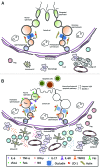Dual role of immune cells in the testis: Protective or pathogenic for germ cells?
- PMID: 23687616
- PMCID: PMC3644047
- DOI: 10.4161/spmg.23870
Dual role of immune cells in the testis: Protective or pathogenic for germ cells?
Abstract
The purpose of this review is to describe how the immune cells present in the testis interact with the germinal epithelium contributing to survival or apoptosis of germ cells (GCs). Physiologically, the immunosuppressor testicular microenvironment protects GCs from immune attack, whereas in inflammatory conditions, tolerance is disrupted and immune cells and their mediators respond to GC self antigens, inducing damage of the germinal epithelium. Considering that experimental models of autoimmune orchitis have clarified the local immune mechanisms by which protection of the testis is compromised, we described the following topics in the testis of normal and orchitic rats: (1) cell adhesion molecule expression of seminiferous tubule specialized junctions and modulation of blood-testis barrier permeability by cytokines (2) phenotypic and functional characteristics of testicular dendritic cells, macrophages, effector and regulatory T cells and mast cells and (3) effects of pro-inflammatory cytokines (TNF-α, IL-6 and FasL) and the nitric oxide-nitric oxide synthase system on GC apoptosis.
Keywords: blood-testis barrier; cytokines; germ cell apoptosis; immune cells; inflammation; nitric oxide; seminiferous tubules; testis.
Figures

Similar articles
-
Testicular autoimmunity.Autoimmun Rev. 2011 Feb;10(4):201-4. doi: 10.1016/j.autrev.2010.09.026. Epub 2010 Oct 14. Autoimmun Rev. 2011. PMID: 20932942 Review.
-
Involvement of soluble Fas Ligand in germ cell apoptosis in testis of rats undergoing autoimmune orchitis.Cytokine. 2012 Nov;60(2):385-92. doi: 10.1016/j.cyto.2012.07.020. Epub 2012 Aug 11. Cytokine. 2012. PMID: 22892327
-
Up regulation of nitric oxide synthase-nitric oxide system in the testis of rats undergoing autoimmune orchitis.Immunobiology. 2012 Aug;217(8):778-87. doi: 10.1016/j.imbio.2012.04.007. Epub 2012 May 17. Immunobiology. 2012. PMID: 22672990
-
Functional and phenotypic characteristics of testicular macrophages in experimental autoimmune orchitis.J Pathol. 2008 Jun;215(2):108-17. doi: 10.1002/path.2328. J Pathol. 2008. PMID: 18381617
-
Germ cell apoptosis and survival in testicular inflammation.Andrologia. 2018 Dec;50(11):e13083. doi: 10.1111/and.13083. Andrologia. 2018. PMID: 30569649 Review.
Cited by
-
Redox metabolism modulation as a mechanism in SSRI toxicity and pharmacological effects.Arch Toxicol. 2020 May;94(5):1417-1441. doi: 10.1007/s00204-020-02721-6. Epub 2020 Apr 4. Arch Toxicol. 2020. PMID: 32246176 Review.
-
Protective effects of fermented goat milk on genomic stability, oxidative stress and inflammatory signalling in testis during anaemia recovery.Sci Rep. 2019 Feb 19;9(1):2232. doi: 10.1038/s41598-018-37649-6. Sci Rep. 2019. PMID: 30783147 Free PMC article.
-
Alterations in oxidative, inflammatory and apoptotic events in short-lived and long-lived mice testes.Aging (Albany NY). 2016 Jan;8(1):95-110. doi: 10.18632/aging.100875. Aging (Albany NY). 2016. PMID: 26805572 Free PMC article.
-
Dual roles of endogenous and exogenous galectin-1 in the control of testicular immunopathology.Sci Rep. 2015 Jul 30;5:12259. doi: 10.1038/srep12259. Sci Rep. 2015. PMID: 26223819 Free PMC article.
-
Integrating miRNA and mRNA Profiling to Assess the Potential miRNA-mRNA Modules Linked With Testicular Immune Homeostasis in Sheep.Front Vet Sci. 2021 May 25;8:647153. doi: 10.3389/fvets.2021.647153. eCollection 2021. Front Vet Sci. 2021. PMID: 34113669 Free PMC article.
References
-
- Nistal M, Riestra ML, Paniagua R. Focal orchitis in undescended testes: discussion of pathogenetic mechanisms of tubular atrophy. Arch Pathol Lab Med. 2002;126:64–9. - PubMed
-
- Jahnukainen K, JørgensenN, Pöllänen P, Giwercman A, Skakkebaek NE. Incidence of testicular mononuclear cell infiltrates in normal human males and in patients with germ cell neoplasia. Int J Androl. 1995;18:313–20. - PubMed
LinkOut - more resources
Full Text Sources
Other Literature Sources
Miscellaneous
